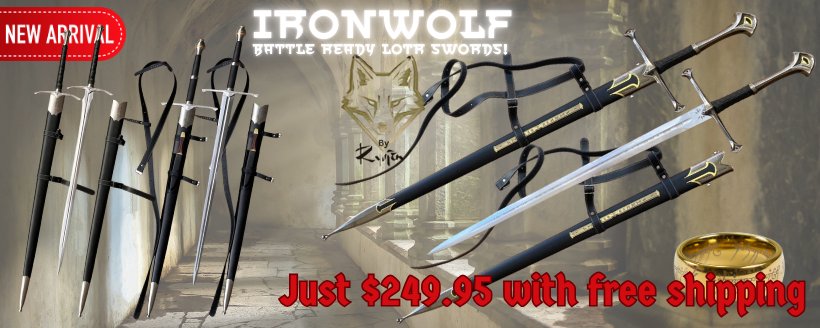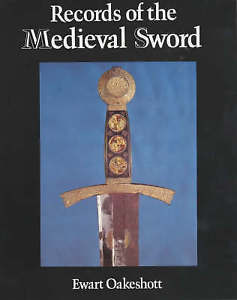Oakeshott Typology Made Easy
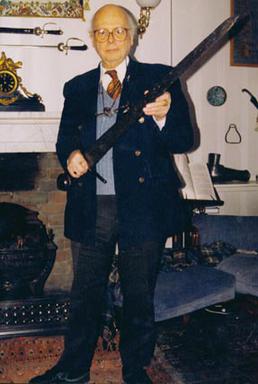 Ewart Oakeshott
Ewart OakeshottAt first glance, Oakeshott typology is anything but easy to understand..
Created by the late historian Ewart Oakeshott as a continuation of the works of Jan Peterson (who classified Viking Swords into 9 main types), his classification system which appeared in his seminal book Records of the Medieval Sword is without a doubt the most detailed and best attempt made to date, but the distinctions between types are often open to interpretation, and have resulted in endless debates on the internet as to what type and category a given sword best fits - a shortcoming that Oakeshott freely admitted.
And it is especially intimidating and confusing to the absolute beginner.
So here is our best attempt to clear up some of the confusion and present the Oakeshott Typology in a manner that anyone can, I hope, intuitively grasp.
Oakeshott Typology Refined:
Two Main Types, Three Main Categories
Please note: Most of the swords that we list as one or two handed could actually be in either configuration and STILL fit within the same type (Oakeshott Typology is quite nebulous in this way). So again, for the sake of over simplification, we have presented them as how they were most commonly configured, understanding that there are always variations and exceptions..
To oversimplify Oakeshott Typology, and medieval swords in general, we can categorize them into two main types and three main categories based on function.
The two main types are pretty simple and are determined by the length of the handle and how many hands are used to wield it:
- One handed Arming Swords (usually used in conjunction with a shield)
- Hand and a Half or Two Handed Swords
The Three main categories are defined by how the sword was primarily used:
- Swords Specialized in the Cut (wider blade, rounded or less acute tip)
- Swords Specialized for the Thrust (extremely pointed, narrower blade and often reinforced by a central rib)
- And General Purpose Cut and Thrust Swords (reasonably wide blade, with a nice pointed tip - the best of both worlds)
This gives us 6 easy to understand new categories or broad types of swords into which all the swords from the Oakeshott Typology can be grouped for easier understanding and reference.
Click to jump to the category of swords you wish to explore first.
RELATED ARTICLE
While we have done our best to make it easy to learn the 24 main types of medieval swords Oakeshott covers in his typology, it is still no easy task to learn all 24 in one sitting. But out of the 24 there are 5 swords that are far more important and were most commonly encountered than the others. Find out what those 5 swords are here!
It also makes it easier to narrow down the Oakeshott Typology of a given sword by its intended use and function - as well as the most common types of pommels (end caps) used which can further help with classification when a given sword cannot easily be categorized.
After all, the categories and types created by Oakeshott were simply descriptions of common design trends observed centuries after the fact, not strict categories, and so some overlap and swords that seemingly defy easy categorization are bound to occur.
A note on using this guide: each sword type has its own dedicated page with detailed information on its history, defining characteristics and the best value for money to historical accuracy ratio fully functional replicas.
One Handed Cutting Swords
Almost all of the one handed dedicated cutting swords in the Oakeshott Typology are early medieval period swords designed to hack and slash through lightly to moderately armored opponents (up to and including maille armor) and tend to be most widely used from the 10th to the 13th centuries.
Type X (type 10)
Early Medieval/Late Viking Era Arming Sword widely used by Normans, Vikings, Anglo-Saxons, and early medieval knights. Wide and Shallow Fuller that runs the length of the blade, disappearing about an inch from the tip. Widely in use from the 9th to the 12th centuries - it was a transitional sword between those used during the Viking and medieval eras respectively.
Click here for detailed information and examples of Type X Swords
Type Xa (type 10a)
A later period version of the Type X with a narrower, deeper fuller than it's parent that was better suited to mounted combat and the forerunner of the early medieval Cavalry Sword, though was equally at home when used on foot. Was in use from the 11th to the 14th century by late period Vikings, Normans, Templars and Knights.
Click here for detailed information and examples of Type Xa Swords
Type XI (type 11)
Early Medieval Cavalry Sword. A longer (typically around 37") blade with narrow fuller designed to be used from horseback. Has an acute tip, but is generally too flexible to deliver a powerful thrust. Was in use during most of the 12th century during the rise of the Knightly social class and dominated the battlefield, before it was largely phased out in the 13th century due to increased use of plate armor, rendering its cuts increasingly ineffective.
Click here for detailed information and examples of Type XI Swords
Type XII (type 12)
Classic Knightly Arming Sword: a versatile single handed sword that was most widely used in the 13th and 14th centuries. Next to the type X and Xa, it is actually one of the most common single handed sword types of the early to mid-medieval era (a saying often heard from modern day collectors is 'when it doubt, it's a type XII!'). Characterized by its shape and profile, with a fuller running 2/3rds of the length of the blade, it was also mounted in a wide variety of fittings. Could have any pommel or cross guard type from that era, though wheel pommels and straight cross guards would be a 'standard' configuration.
Click here for detailed information and examples of Type XII Swords
Type XIIIb (type 13b)
An knightly arming sword that specialized in the cut and was
primarily used to devastating effect from horseback against maille clad
footsoldiers that developed from the earlier Type XI. Identifiable by a
blade whose edges run parallel before terminating suddenly in a
spatulate tip and a shorter fuller, providing a wide shearing surface
for cutting. Was relatively rare and quite specialized.
Click here for detailed information and examples of Type XIIIb Swords
One Handed Thrusting Swords
One handed swords optimized to thrust into the weak points of plate armor typically appeared between the 14th and 15th centuries.
Type XV (type 15)
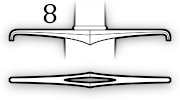
Armor Piercing Arming Sword: with either a diamond or hollow ground profile, Type XV swords were typically stiff, long and extremely pointed blades designed to pierce maille and the weak points/joints in plate armor. While any crossguard from the period could be used, type 8 (pictured) was the most common for a type 15 sword. In use from the 14th to the 15th centuries, but somewhat specialized in its use.
Click here for detailed information and examples of Type XV Swords
One Handed Cut & Thrust
The cut and thrust swords pick up where the cut only orientated swords left off, with the majority of them first created in the 13th to the 15th centuries and wholly replaced the earlier period cutting swords as a response to changes in the types of armor that could be encountered on the battlefield.
Type XIa (type 11a)
A variant of the cavalry Type XI but with a broader, stiffer blade suitable for both cutting and thrusting. Used primarily in the 12th century during the rise of the mounted medieval knights importance, both as a social rank and on the battlefield. A very rare sub type.
Click here for detailed information and examples of Type XIa Swords
Type XIV (type 14)
Single handed medieval broadsword with a single wide fuller or multiple narrow partial length fullers and mounted with a wheel pommel (exclusively, most commonly Type K) designed for versatile use in cutting and thrusting. Extremely popular and commonly used during the late 13th century to the mid 14th century, it was also one of the last swords made for defeating maille armor.
Click here for detailed information and examples of Type XIV Swords
Type XVI (type 16)
Fullered down to 1/2 the length of the acutely tapering/pointed blade. Was a versatile blade type that was good at both cutting and thrusting, though was slightly more efficient at thrusting and very effective against armored opponents. Used primarily in the early 14th century at the height of the medieval arms race of swords versus armor.
Click here for detailed information and examples of Type XVI Swords
Type XVIII (type 18)
Typically Hollow ground or with a raised central rib to reinforce the blade in the thrust, but tapers gradually to a point making it both effective in the cut and the thrust. Any type of cross guard from the era could be used, but type 11 (pictured) with a downward curve was prominent. Used throughout the 15th century as lighter armor was used in response to increased use of projectile weapons on the battlefield.
Click here for detailed information and examples of Type XVIII Swords
Type XIX (type 19)
Broad, flat blades with a hexagonal cross section and narrow fuller designed for both cutting and thrusting. Commonly featured additional cosmetic grooves on the ricasso. A later period sword used mostly in the mid 15th century but spanned from the high middle ages well into the renaissance.
Click here for detailed information and examples of Type XIX Swords
Type XXI (type 21)
Type XXI swords include the the Italian Cinquedea and similar styled swords with longer, less broad blades but a similar profile. Typically outfitted with a curved cross guard and has multiple fullers. Another later period sword used in the mid 15th century - often gilded and highly decorated - as much a status symbol as a weapon.
Click here for detailed information and examples of Type XXI Swords
Type XXII (type 22)
Flat, hexagonal profile blade with 2 short, deep and narrow fullers. Appeared slightly before the Type 21 in the late 14th century until the mid 15th century and into the early Renaissance period (some were massive two handers). Quite rare, with few surviving examples and rarely represented in the replica production sword market.
Click here for detailed information and examples of Type XXII Swords
Two Handed Cutting Swords
Typically used by a knight that would rely on his plate armor to protect him, these swords were capable of inflicting terrible wounds on foot-soldiers and delivering concussive blows to other armored knights that were enough to knock them senseless and prepare them for the coup de grace.
Type XIIa (type 12a)
A versatile Great Sword of War with a fuller 2/3rds of the length of the blade, it is primarily a cutter but its acute tip and overall rigidity also makes it suitable for devastating thrusts. Commonly used on the battlefields of the 13th and 14th centuries, it is what most people think of when they try to imagine a knightly two handed longsword.
Click here for detailed information and examples of Type XIIa Swords
Type XIII (type 13)
Wide blade with parallel edges and 1/2 length fuller (wide or multiple) terminating with a spatulate tip. Somewhat unusual in that the blade would be better suited to single hand use, but is instead outfitted with a hand and a half grip handle. From the middle of the 13th century to the late 14th. Was a rare sword type historically and functional replicas, even rarer still.
Click here for detailed information and examples of Type XIII Swords
Type XIIIa (type 13a)
Also known as a Great Sword of War or Great Warsword, these were powerful cutting swords with a wide blade and single or multiple fullers running 1/2 the length of the blade terminating in a rounded or spatulate tip. A popular sword in use from the middle of the 13th to the latter half of the 14th centuries - and adopted by the Scottish in their wars against the English from the 15th to the 18th centuries in the form of the claidheamh-mór commonly (but mistakenly) known as a 'Claymore'.
Click here for detailed information and examples of Type XIIIa Swords
Type XX (type 20)
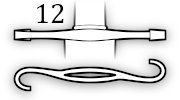
A broad blade with two shallow but wide fullers extending 1/4 the length of the blade, this cut and thrust sword was in use during the 14th and 15th centuries and was the last of the true two handed fighting swords. While any cross guard could and was used. most were outfitted with type 12 (pictured). Most had a lenticular profile, but the rarer octagonal profile was also sometime seen. A relatively rare sword type.
Click here for detailed information and examples of Type XX Swords
Two Handed Thrusting Swords
Appearing in the 14th century, these massive swords were used to pierce the weak points in plate armor and were often gripped at the forte of the blade in a technique known as 'half swording' to deliver spear like penetration.
Type XVa (type 15a)
The classic 'Longsword' or 'Bastard Sword'. With the same characteristics as the single handed Oakeshott Typology XV - the two handed XVa has a longer, narrower blade and grip for two handed use and were specialized weapons primarily designed to use against heavily armored opponents. Any type of period cross guard could be used, but type 8 (pictured) was the most common. Widely used and very common in the 14th and 15th centuries and frequently appearing in the fight manuals of Talhoffer, Ringeck and Fiore.
Click here for detailed information and examples of Type XVa Swords
Type XVIa (type 16a)
Used primarily for thrusting but with a wide enough blade to still make effective cuts, the Type XVIa has a relatively wide blade terminating in a very serviceable tip, two handed grip and 1/3rd length fuller. Appeared and disappeared in the early 14th century and could and often did use any type of cross guard from the period with no specific style being particularly prominent. Versatile against armored and lightly armored opponents, yet relatively rare.
Click here for detailed information and examples of Type XVIa Swords
Type XVII (type 17)
The kind of sword that St. George might have equipped himself with to slay a dragon. Powerfully built and usually with no or a short fuller, these hexagonal cross sectioned blades were used to take an all types of armor, often being used to cause impact damage and crack armor as well as pierce it at the weak points with a direct thrust or even a full force swipe. Used from the mid 14th to the early 15th century with the most famous example based on a sword found in the River Ouse.
Click here for detailed information and examples of Type XVII Swords
Two Handed Cut & Thrust
Versatile and terrible on the battlefield, two handed cut and thrust swords were at their peak use in the 15th century and could be used to cut lightly armored opponents or half sword into the weak points of plate.
Type XVIIIa (type 18a)
Appearing in the 15th century and used from around 1410 to 1510, Type XVIIIa represents a later period Knightly Longsword that hearkened back to earlier, more versatile sword types as the trend towards heavy armors on the battlefield stared to reverse due to increased use of missile weapons. The long, relatively slender blades (usually with a partial fuller) combined the best of the cut without losing the ability to deal an armor piercing thrust when necessary. Could be mounted with any type of pommel or cross guard from the period, though types 1-3 were favored.
Click here for detailed information and examples of Type XVIIIa Swords
Type XVIIIb (type 18b)
Germanic Longsword: Hollow ground, diamond cross sectional blade with a reinforced tip - this Longsword type is well balanced between cut and thrust and often features a waisted grip. A later period medieval sword used between the mid 15th to the early 16th century that was especially popular in Germany.
Click here for detailed information and examples of Type XVIIIb Swords
Type XVIIIc
A broad bladed Longsword with diamond cross sectioned blade terminating in an armor piercing tip. Similar to the Type XVIIIb but starting with a much wider, distinctive base. Relatively rare and somewhat specialized, was in use throughout most of the 15th century, though developed in the late 14th.
Click here for detailed information and examples of Type XVIIIc Swords
Type XXa (type 20a)
The Type XXa is a rather narrow category of swords. Essentially almost identical to the parent type XX swords - a dedicated cutting sword - it was different only in terms of a slightly more slender blade and a more acutely pointed tip, giving it the versatility of a cut and thrust sword. As with the 'pure' type 20, it was widely in use in the 14th and 15th centuries.
Click here for detailed information and examples of Type XXa Swords
Guard Types
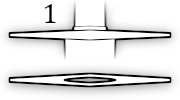
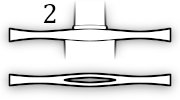
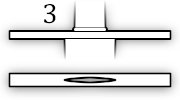
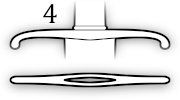
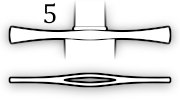
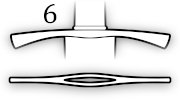
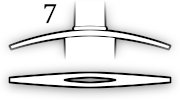

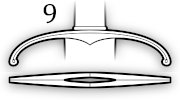
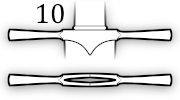
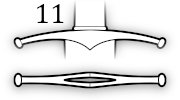

Pommel Types































Further Resources
Naturally the best place to learn Oakeshott Typology is the book where he first published his classification system, Records of the Medieval Sword.
However, there are some great free resources available on the web to further refine and explore his typology here at My Armory and here at the Albion Swords website.
I hope this information on the Oakeshott Typology has been helpful. To return to Affordable Replicas of Medieval Swords from Oakeshott Typology Made Easy, click here

Buying Swords Online Can Be DANGEROUS!
Find the Best Swords in the:
Popular & Recommended ARTICLES

The ONLY true free online magazine for sword enthusiasts. Delivered once a month on the 1st day of the month, no filler and no BS, just the latest sword news & info delivered straight to your inbox.

